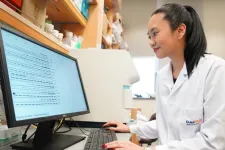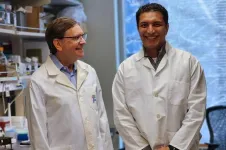(Press-News.org) GRAND RAPIDS, Mich. (July 17, 2024) — Van Andel Institute scientists have identified more than 1,000 previously undetected proteins in common metabolite samples, which persist despite extraction methods designed to weed them out.
The findings, published in Nature Communications, give scientists new insights and tools for improving future metabolomics experiments, including a novel protocol for removing these proteins during the extraction process. The study does not invalidate prior results but instead reinforces the importance of appropriate controls and validation in experimental design and analysis.
“Scientific advances often happen through a combination of chance and keen observation. In this case, we noticed a strange result during an experiment, dug into it and found this vast landscape of proteins that were slipping by standard metabolite extractions,” said Ryan Sheldon, Ph.D., director of VAI’s Mass Spectrometry Core and corresponding author of the study. “These proteins can obscure results and potentially contribute to false positives and negatives. We hope our findings will raise awareness of these proteomic stowaways and further strengthen the metabolomics field.”
It has long been assumed that the chemicals used to extract metabolites destroy proteins present in samples, thus preventing them from interfering with the final analysis. The study demonstrates that some proteins endure, which may shift the desired phenotype of the extracted sample and alter results.
To screen out these potentially problematic proteins, Sheldon and colleagues added a filtration step to their standard extraction process that removes proteins larger than 3 kilodaltons — a threshold that encompasses most proteins.
“At the end of the day, we can have the best instrumentation in the world but if there are issues with sample preparation, then the technology can only take us so far,” Sheldon said. “Ensuring that our phenotypes are free of any confounding proteins is critical to attaining accurate results. Our findings help us do just that.”
The study was spearheaded by VAI Mass Spectrometry Core Research Scientist Molly Hopper, Ph.D., and then-Van Andel Institute Graduate School student Rae House, Ph.D. House is now a Cancer Epigenetics Training Program-supported postdoctoral fellow in the lab of Evan Lien, Ph.D., at VAI.
Other authors include Michael P. Vincent, Ph.D., Abigail E. Ellis, Colt D. Capan, M.S., Zachary B. Madaj, M.S., Emily Wolfrum, MPH, Christine N. Isaguirre, Carlos D. Castello, Amy B. Johnson, Martha L. Escobar-Galvis, Ph.D., Kelsey S. Williams, Ph.D., and Hyoungjoo Lee, Ph.D., of Van Andel Institute.
Research reported in this publication was supported by Van Andel Institute’s Core Technologies and Services (Mass Spectrometry Core and Bioinformatics and Biostatistics Core); Van Andel Institute’s Metabolism and Nutrition (MeNu) Program; and the National Cancer Institute of the National Institutes of Health under award no. T32CA251066 (P. Jones). The content is solely the responsibility of the authors and does not necessarily represent the official views of the National Institutes of Health.
###
ABOUT VAN ANDEL INSTITUTE
Van Andel Institute (VAI) is committed to improving the health and enhancing the lives of current and future generations through cutting edge biomedical research and innovative educational offerings. Established in Grand Rapids, Michigan, in 1996 by the Van Andel family, VAI is now home to more than 500 scientists, educators and support staff, who work with a growing number of national and international collaborators to foster discovery. The Institute’s scientists study the origins of cancer, Parkinson’s and other diseases and translate their findings into breakthrough prevention and treatment strategies. Our educators develop inquiry-based approaches for K–12 education to help students and teachers prepare the next generation of problem-solvers, while our Graduate School offers a rigorous, research-intensive Ph.D. program in molecular and cellular biology. Learn more at vai.org.
END
A new study found that increased exposure to residential greenery may help stave off cognitive decline by an annual rate of eight months. This delay was observed more among people living in low-socioeconomic status and highly populated neighborhoods, as well as people who carry the APOE-ɛ4 gene, which is associated with an increased risk of Alzheimer’s disease.
Research has shown that about 40 percent of dementia could be prevented or delayed worldwide by addressing modifiable risk factors associated with the condition, particularly during midlife.
A new study led by a Boston University School of Public Health (BUSPH) ...
When trying to understand the present, it's helpful to look to history. New research from the University of Nebraska–Lincoln examined the fossil record going back 66 million years and tracked changes to mammalian ecosystems and species diversity on the North American continent.
The study, led by Alex Shupinski, who earned her doctorate in May, and co-authored by Kate Lyons, associate professor in the School of Biological Sciences, provides a large-scale view of how species diversity changed over the first 65 million years of the Cenozoic era — up until the arrival of humans — ...
Winston-Salem, North Carolina — July 17, 2024 — The RegeneratOR Test Bed, located in Innovation Quarter, announces the inclusion of Cytoink into its pioneering ecosystem dedicated to advancing biomedical research and development. Cytoink brings cutting-edge biomaterials manufacturing, with over 100 custom formulations, and bioprinting expertise that merges biofunctionality with high-throughput production. Cytoink specializes in the biofabrication of in vitro 3D tissue phantoms, extrusion-based and light-based (DLP/VAM) bioinks, and integrated perfusion microfluidics bioreactors. Additionally, Cytoink provides bespoke biomaterial solutions ...
Jeffrey Spraggins, associate professor of cell and developmental biology, biochemistry, and chemistry, has been named director of the Mass Spectrometry Research Center. He succeeds Richard Caprioli, Stanford Moore Chair in Biochemistry, who established the MSRC in 1998 and who is retiring this summer.
Spraggins is a leading scientist in spatial biology and imaging mass spectrometry—an untargeted molecular imaging approach that enables molecular mapping at cellular resolution—a technology originated by Caprioli. Spraggins’ research lies at the intersection of technology development, data science, and biomedical research. His research group ...
An ageing population will bring colossal health, social, and economic challenges over the coming decades[1]. As people live longer, staving off the physical decline and frailty that come with age has become a holy grail, with effective interventions projected to unlock significant societal and economic benefits. Estimates suggest that a slowdown in ageing that increases life expectancy by one year alone is worth US$38 trillion.[2]
In a discovery published in Nature, a team of scientists from Duke-NUS Medical School in Singapore may have found a key to slow ageing.
The ...
Researchers have analysed data from 127 studies to reveal ‘thresholds’ for when logged rainforests lose the ability to sustain themselves.
The results could widen the scope of which forests are considered ‘worth’ conserving, but also show how much logging degrades forests beyond the point of no return.
The first-of-its-kind study, led by researchers from the Department of Life Sciences at Imperial College London with collaborators from around the world, is published today in ...
UNIVERSITY PARK, Pa. — Astronomers have discovered a planet that has the most oblong orbit ever found among transiting planets. The exoplanet’s extreme circuit — which looks closer to a cucumber than a circle — follows one of the most drastically stretched-out orbits of all known exoplanets, planets that orbit stars outside our solar system. It is also orbiting its star backwards, lending insight into the mystery of how close-in massive gas planets, known as hot Jupiters, form, stabilize and evolve over time.
The research, led by Penn State scientists, was published today (July 17) in ...
Scientists at the Medical Research Council Laboratory of Medical Science and Imperial College London have discovered that ‘switching off’ a protein called IL-11 can significantly increase the healthy lifespan of mice by almost 25%.
The scientists, working with colleagues at Duke-NUS Medical School in Singapore, tested the effects of IL-11 by creating mice that had the gene producing IL-11 (interleukin 11) deleted. This extended the lives of the mice by over 20% on average.
They also treated 75-week-old mice – equivalent to the age of about 55 years in humans – with an ...
A new gene therapy treatment for Duchenne muscular dystrophy shows promise of not only arresting the decline of the muscles of those affected by this inherited genetic disease, but perhaps, in the future, repairing those muscles.
The UW Medicine-led research focuses on delivering a series of protein packets inside shuttle vectors to replace the defective DMD gene within the muscles. The added genetic code will then start producing dystrophin, the protein lacking in patients with muscular dystrophy.
Currently, there is no cure for the disease ...
A major obstacle for net zero technologies in combatting climate change is bridging the gap between fundamental research and its application in the real world.
This gap, sometimes referred to as ‘the valley of death’, is common in the field of carbon capture, where novel materials are used to remove carbon dioxide from flue gasses produced by industrial processes. This prevents carbon from entering the atmosphere, helping to mitigate the effects of climate change.
Chemists have proposed and ...








